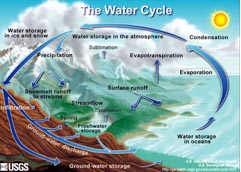Glossary of Aviation Terms | Precipitation
Precipitation | Paramount Business Jets
Precipitation is any form of water that is present in the atmosphere. It is a class of hydrometeors, which are atmospheric water phenomena. Precipitation can be in many forms, ranging from snow to fog. It occurs when the atmosphere becomes saturated with water vapor (a gaseous form of water) and condenses, falling out of its form. Air saturation can be caused by two main processes, either together or individually: cooling of the air or water vapor being added to the air.
There are four main ways in which air can be cooled to its dew point: adiabatic cooling, conductive cooling, radiation cooling, and evaporative cooling.
Adiabatic cooling: occurs when air rises. In the troposphere, as altitude increases, the temperature decreases, and this causes air to condense. The rising of air can be accomplished by convection (heating), very large atmospheric phenomena, or being forced due to a physical barrier such as a mountain.
Conductive cooling: occurs when warmer air comes in contact with a cooler surface. It is best represented as fog in the early morning over a field. Warmer air is blown over the colder ground and causes the formation of fog.
Radiation cooling: occurs when there is an emission of infrared light from the air underneath the surface.
Evaporative cooling: occurs most effectively when dry air is blown over a wet surface. Energy from the air is used to evaporate the water.

The other way that air can be saturated is by adding water vapor to it. This is most commonly done by evaporation or evapotranspiration. Since water can only be added to the air by being high energy, you need to have a transfer of energy from warm air to colder water. This excites the water and allows it to escape the surface and turn into water vapor. The main ways' water vapor is added to the air are by precipitation falling from above, daytime heating evaporating water from moist surfaces, the transpiration from plants, or drier air moving over open water.
With the presence of water vapor in the air, precipitation is the next step. Precipitation always starts out with condensation. As the water vapor rises, it cools and becomes denser, forcing it to condense into droplets. Once the droplets get big enough, coalescence, or the Bergeron process, sets in. Coalescence is when the droplets fuse into rain or freeze into ice. They eventually descend to the Earth as precipitation. The Bergeron process is when ice crystals gain droplets from nearby, creating super-cooled droplets. These droplets eventually become big enough and fall to the ground as precipitation.

Due to all the ways that water vapor can change temperature, gain or lose altitude, and condense, there are many forms of precipitation that can come about. Not only are there many kinds of precipitation that can form, but it can also fall to the Earth in different ways. Snow, sleet, hail, ice, rain, mist, fog, freezing rain, and drizzle are all forms of rain.
It can fall to the surface in storms, sun showers, humidity, and virga, which is potentially dangerous for aircraft. Virga is when the rain falls on the Earth’s surface and evaporates before it hits the ground, causing it to rise again. This is a sign of thermal pockets and can cause extreme turbulence for all aircraft.
Larger aircraft fly above the clouds at the top of the troposphere, so precipitation isn’t much of a problem. In fact, when larger aircraft fly through precipitation, it doesn’t cause much of an issue. In the absence of wind, turbojet and turboprop aircraft can fly through precipitation without any serious issues, and smaller aircraft might not have much of an issue. However, precipitation causes the most risk to aircraft when it is present in colder air. This can cause the formation of ice on the aircraft, which is a real hazard. Ice causes a loss of lift and an increase in weight, forcing the plane to have a serious decrease in performance. In order to avoid situations in which precipitation could cause an accident, pilots will receive weather briefings both before the flight while on the ground and while in the air.
Explore More Aviation Terminology
- Radio | Paramount Business Jets
- Instrument Meteorological Conditions | Paramount Business Jets
- Flaps | Paramount Business Jets
- Cardinal Altitude | Paramount Business Jets
- Retail Quote | Paramount Business Jets
- Charter Operator | Paramount Business Jets
- VFR Flight Plan | Paramount Business Jets
- Third Party Verification | Paramount Business Jets
- Helipad | Paramount Business Jets
